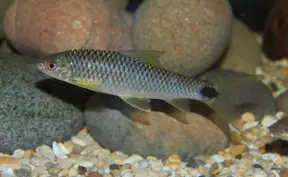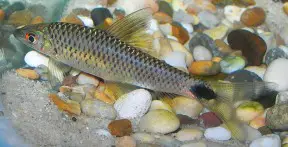Crossocheilus reticulatus
SynonymsTop ↑
Holotylognathus reticulatus Fowler, 1934; Crossocheilus reticulatus Fowler, 1935; ? Crossocheilus tchangi Fowler, 1935; Tylognathus coatesi Fowler, 1937
Etymology
Crossocheilus: from the Ancient Greek κροσσός (krossós), meaning ‘fringe, tassel’, and χείλος (cheílos), meaning ‘lip’, in reference to the barbels on the upper lip in members of this genus.
reticulatus: from the Latin reticulatus, meaning ‘reticulated’, in reference to this species’ net-like colour pattern.
Classification
Order: Cypriniformes Family: Cyprinidae
Distribution
Occurs throughout the Chao Phraya river drainage in central Thailand and the Mekong basin in eastern Thailand, Cambodia, Laos, Vietnam and southern China (Yunnan province).
Type locality is ‘Bua Yai, Nokorn-Rajsima, eastern Thailand’.
Habitat
Crossocheilus species inhabit flowing streams and tributaries with substrates of boulders, pebbles, gravel and sand, often in areas with submerged driftwood or tree roots.
The clear, often shallow, water allows sunlight to penetrate the surface and the development of a rich biofilm covering submerged surfaces upon which the fish browse, although seasonal variations in volume, flow, and turbidity can be considerable.
Maximum Standard Length
One of the larger members of the genus reaching 160 – 170 mm.
Aquarium SizeTop ↑
A group would require an aquarium with base measurements of 180 ∗ 45 cm or equivalent.
Maintenance
This species will do well in most well-maintained tanks but we highly recommend keeping it in a set-up designed to resemble a flowing river or stream, with a substrate of variably-sized rocks, gravel and some large water-worn boulders.
It can be further furnished with driftwood branches arranged to form a network of nooks, crannies and shaded spots.
While the majority of plant species will fail to thrive in such surroundings hardy types such as Microsorum, Bolbitis or Anubias spp. can be grown attached to the décor and bright lighting will promote the growth of algae upon which the fish will graze.
In this kind of environment it will display more natural behaviour and can be kept alongside other species that enjoy similar conditions.
Like many fishes that naturally inhabit running waters it’s intolerant to the accumulation of organic wastes and requires spotless water at all times in order to thrive.
It also does best if there is a high level of dissolved oxygen and a decent level of water movement in the tank so external filters, powerheads or similar should be employed in order to obtain the desired effect.
Water Conditions
Temperature: 16 – 24 °C
pH: 6.0 – 7.5
Hardness: 18 – 215 ppm
Diet
In nature Crossocheilus species are aufwuchs grazers feeding on algae, diatoms and other phytoplankton, plus associated microorganisms.
The use of high-protein foods should therefore be avoided as the fish are unable to metabolise them efficiently, and regular consumption can result in excessive deposits of fat and even organ degeneration.
A good quality dried product(s) with added Spirulina or similar is ideal but plenty of fresh vegetable matter should also be included in the diet. Shelled peas, blanched courgette, spinach and chopped fruit all make good additions to the menu as well.
Once settled into the aquarium the fish sometimes ascend into midwater to feed and in a set-up as described above will often be seen browsing the biofilm that tends to form on the rockwork.
Behaviour and CompatibilityTop ↑
Generally peaceful and can be maintained alongside many of the more popular species in the hobby although it is perhaps preferable to select fishes from one of its native countries or rivers.
Possibilities also exported from Thailand include numerous loach and cyprinid species.
Crossocheilus spp. are typically found swimming in loose aggregations in nature and can exhibit shy or skittish behaviour if kept singly or in small numbers.
They are shoaling, rather than schooling, fishes which develop a distinct pecking order and are best-maintained in a group of six or more since weaker individuals may be bullied incessantly if smaller numbers are kept. You’ll be rewarded with a more natural-looking display plus interesting behaviour from the fish as they interact with one another.
Sexual Dimorphism
Sexually mature females are normally thicker-bodied than males but it’s impossible to accurately sex young fish by external characters.
Reproduction
Not thought to have occurred in the aquarium hobby and as far as we know it’s not being farmed for the trade although related species are induced to spawn artificially via the use of hormones.
Members of this genus are known to undergo seasonal reproductive migrations in nature, moving upstream during the dryer months and in the opposite direction when water levels rise.
NotesTop ↑
This species is usually offered under the names ‘reticulated/fishnet flying fox’ in reference to the attractive colour pattern and it makes an excellent aquarium subject when maintained correctly.
While some laterally-striped members of the genus look very similar to one another the combination of silvery body, dark-edged scales and dark caudal peduncle blotch set C. reticulatus uniquely apart.
The names Crossocheilus tchangi, Epalzeorhynchos coatesi and E. stigmaeus are all now considered synonyms of the species but were erected because the fish vary, most often in minor aspects of patterning, depending on collection locality.
Members of Crossocheilus are characterised by possessing 8 branched dorsal fin rays, immobile rostral lobes, lacking a dorsal spine and by the fact that the upper and lower lips aren’t connected, the upper being attached to the lower jaw via a thin membrane.
References
- Fowler, H. W., 1935 - Proceedings of the Academy of Natural Sciences of Philadelphia v. 87: 89-163
Zoological results of the third De Schauensee Siamese Expedition, Part VI - Fishes obtained in 1934. - Bănărescu, P. M., 1986 - Travaux du Muséum d'Histoire Naturelle 28: 141-161
A review of the species of Crossocheilus, Epalzeorhynchos and Paracrossochilus (Pisces, Cyprinidae). - Freyhof, J., D. V. Serov and T. N. Nguyen, 2000 - Bonner Zoologische Beiträge 49(1-4): 93-99
A preliminary checklist of the freshwater fishes of the River Dong Nai, South Vietnam. - Kottelat, M., 2003 - Raffles Bulletin of Zoology 51(2): 399-401
Nomenclatural status of Crossocheilus burmanicus, C. horai and C. multirastellatus (Osteichthyes: Cyprinidae). - Kottelat, M., 2013 - The Raffles Bulletin of Zoology Supplement 27: 1-663
The fishes of the inland waters of southeast Asia: a catalogue and core bibiography of the fishes known to occur in freshwaters, mangroves and estuaries. - Kottelat, M., 2001 - WHT Publications, Colombo: 1-198
Fishes of Laos. - Kottelat, M. and H. H. Tan, 2011 - The Raffles Bulletin of Zoology 59(2): 195-199
Crossocheilus elegans, a new species of fish from northern Borneo (Teleostei: Cyprinidae). - Rainboth, W. J., 1996 - FAO, Rome: 1-265
Fishes of the Cambodian Mekong. FAO Species Identification Field Guide for Fishery Purposes. - Su, R.-F., J.-X. Yang and Y.-R. Chen, 2000 - The Raffles Bulletin of Zoology 48(2): 215-221
A review of the Chinese species of Crossocheilus, with description of a new species (Ostariophysi: Cyprinidae).










July 25th, 2012 at 5:18 pm
My personal experience with C. reticulatus is very different as far as temperature recommendations are concerned. My fish are most active and show their best colours or rather patterning below 21º C. When, during summer months, temperatures rise above 22 – 23º C in the aquarium, I have to airate the tank aditionally since the fish show obvious discomfort most likely due to a lack of oxygen. However, even with raised oxygen levels, the fish are not as active as they are at lower temperatures. Any similar exeperiences??
Regards
R.
July 26th, 2012 at 8:15 am
Hi Rüdiger – what’s the lowest temperature you’ve maintained this species at?
July 26th, 2012 at 12:11 pm
Hi Matt.
I keep them (obviously) in an unheated tank. During the coldest period in Winter temps drop down to 16* C at night and slowly rise to 19* C throughout the day. Other species in the tank are Tanichthys albonubes, Badis badis, Danio choprae, Danio rerio, Sewellia lineolata, Puntius oligolepis, Dermogenys pusIlla and Hara jerdoni. All of them cope perfectly fine with the low temps. I recon you could even go as low as 12* C for a week or two.
December 15th, 2012 at 10:52 am
After recording temperatures and resulting activities for a year now I can say that in my set up C. reticulatus seems most comfortable at 19* C. They have started what can only be courtship behaviour yesterday. 🙂 Details after more observation.
Regards
R.
December 17th, 2012 at 11:35 pm
That makes sense. The Badis and Rhinogobius here go down to around 15°C at night during winter too.
Have made some changes based on your recommendations Rudi. Please do keep us updated if you observe anything interesting.
August 28th, 2013 at 9:52 am
I have 10 crossocheilus reticulatus with 10 puntius titteya and several shrimps in a heavily planted 240 liters.
I have noticed that they around feeding time let out 1-2 air bubbles. Must be a way to say to each other that its feeding time.
Have anyone else noticed this behavior???